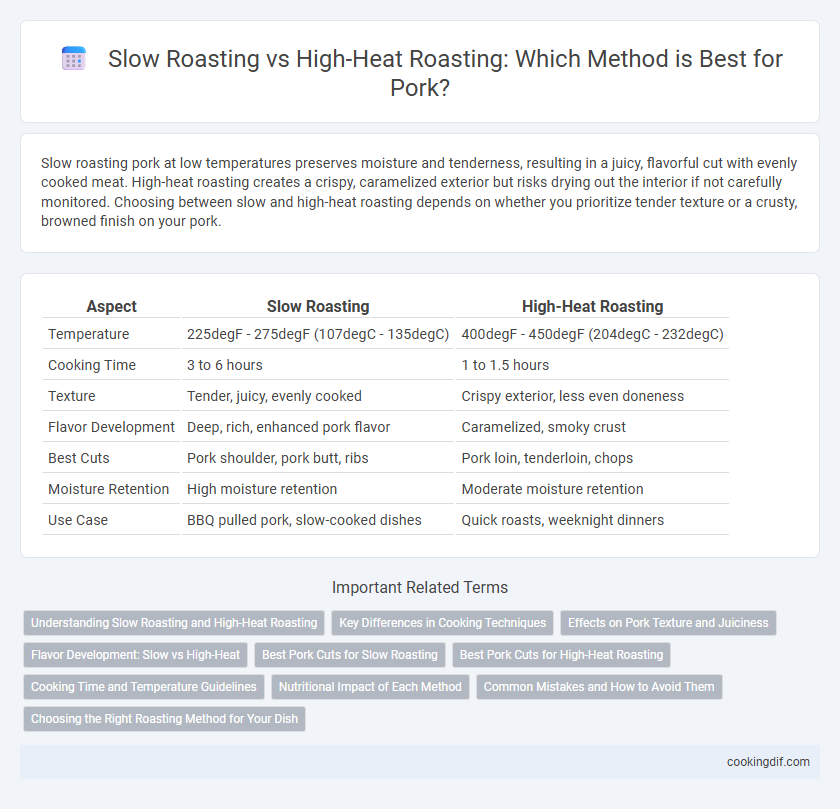Slow roasting pork at low temperatures preserves moisture and tenderness, resulting in a juicy, flavorful cut with evenly cooked meat. High-heat roasting creates a crispy, caramelized exterior but risks drying out the interior if not carefully monitored. Choosing between slow and high-heat roasting depends on whether you prioritize tender texture or a crusty, browned finish on your pork.
Table of Comparison
| Aspect | Slow Roasting | High-Heat Roasting |
|---|---|---|
| Temperature | 225degF - 275degF (107degC - 135degC) | 400degF - 450degF (204degC - 232degC) |
| Cooking Time | 3 to 6 hours | 1 to 1.5 hours |
| Texture | Tender, juicy, evenly cooked | Crispy exterior, less even doneness |
| Flavor Development | Deep, rich, enhanced pork flavor | Caramelized, smoky crust |
| Best Cuts | Pork shoulder, pork butt, ribs | Pork loin, tenderloin, chops |
| Moisture Retention | High moisture retention | Moderate moisture retention |
| Use Case | BBQ pulled pork, slow-cooked dishes | Quick roasts, weeknight dinners |
Understanding Slow Roasting and High-Heat Roasting
Slow roasting pork at temperatures between 225degF and 275degF ensures tender, juicy meat by allowing collagen to break down gradually, resulting in enhanced flavor development and moisture retention. High-heat roasting, typically at 400degF or above, creates a crispy, caramelized crust quickly but risks drying out the interior if not monitored carefully. Understanding the balance between these methods helps achieve the desired texture and taste in pork dishes.
Key Differences in Cooking Techniques
Slow roasting pork involves cooking at low temperatures (around 225-275degF) for an extended period, allowing collagen to break down and resulting in tender, juicy meat. High-heat roasting uses temperatures above 400degF, creating a caramelized crust and a shorter cooking time but risks drying the pork if not carefully monitored. The key difference lies in moisture retention and texture: slow roasting produces a uniformly tender interior, while high-heat roasting emphasizes a crispy exterior with a potentially firmer inside.
Effects on Pork Texture and Juiciness
Slow roasting pork at low temperatures allows collagen to break down gradually, resulting in tender, juicy meat with a melt-in-the-mouth texture. High-heat roasting sears the exterior quickly, creating a crispy crust but can cause the interior to dry out and become tougher. Balancing cooking time and temperature is key to optimizing pork's texture and juiciness during roasting.
Flavor Development: Slow vs High-Heat
Slow roasting pork at low temperatures enhances flavor development by allowing collagen to break down gradually, resulting in tender, juicy meat with deep, concentrated flavors. High-heat roasting creates a flavorful crust through the Maillard reaction but may lead to uneven cooking and less tender texture. Balancing temperature and time is crucial for optimal flavor and texture in pork roasting.
Best Pork Cuts for Slow Roasting
Slow roasting is ideal for tougher pork cuts like pork shoulder, pork butt, and pork belly, as the extended cooking time at low temperatures breaks down connective tissues, resulting in tender and flavorful meat. These cuts benefit from slow roasting processes at temperatures around 225-275degF (107-135degC), which preserve moisture and enhance the natural pork flavor. In contrast, high-heat roasting suits leaner cuts like pork loin and tenderloin that cook quickly without drying out.
Best Pork Cuts for High-Heat Roasting
High-heat roasting is ideal for pork cuts like tenderloin, shoulder, and loin roast, which benefit from quick cooking to develop a crispy exterior while retaining juicy interiors. These cuts have balanced fat content and tender muscle fibers that respond well to intense temperatures, enhancing flavor and texture. Slow roasting suits tougher cuts like pork butt or ribs, but for best high-heat roasting results, choose leaner cuts with moderate marbling for optimal caramelization and succulence.
Cooking Time and Temperature Guidelines
Slow roasting pork at 250-300degF requires 25-30 minutes per pound, ensuring tender, evenly cooked meat with retained moisture. High-heat roasting involves cooking at 400-450degF for 15-20 minutes per pound, producing a crisp exterior and faster cooking time but with a higher risk of drying out. Choosing between these methods depends on desired texture and available cooking time, optimizing flavor and juiciness through precise temperature control.
Nutritional Impact of Each Method
Slow roasting pork at lower temperatures helps retain more moisture and preserve essential nutrients like B vitamins and minerals, reducing nutrient loss caused by extended cooking times. High-heat roasting quickly seals the meat, enhancing flavor but may lead to greater nutrient degradation and formation of harmful compounds due to increased protein oxidation. Choosing slow roasting improves the nutritional profile by preserving tenderness and nutrient density, while high-heat roasting prioritizes taste but with a possible reduction in vitamin retention.
Common Mistakes and How to Avoid Them
Slow roasting pork preserves juiciness and tenderness by cooking at low temperatures for extended periods, but common mistakes include insufficient seasoning and not allowing the roast to rest, which can result in bland flavors and dry texture. High-heat roasting quickly develops a flavorful crust but often causes uneven cooking and tougher meat if not monitored closely or if the internal temperature exceeds 145degF (63degC). To avoid these pitfalls, use a meat thermometer for precise temperature control, season liberally, and let the pork rest for at least 10-15 minutes before carving.
Choosing the Right Roasting Method for Your Dish
Slow roasting pork at temperatures around 225-275degF ensures tender, juicy meat by breaking down connective tissues over time, ideal for larger cuts like pork shoulder. High-heat roasting at 400-450degF quickly develops a crispy crust and caramelized exterior, making it perfect for smaller cuts such as pork loin or tenderloin. Selecting the right roasting method depends on cut size, desired texture, and cooking time, balancing flavor development with moisture retention.
Slow roasting vs High-heat roasting for pork Infographic

 cookingdif.com
cookingdif.com